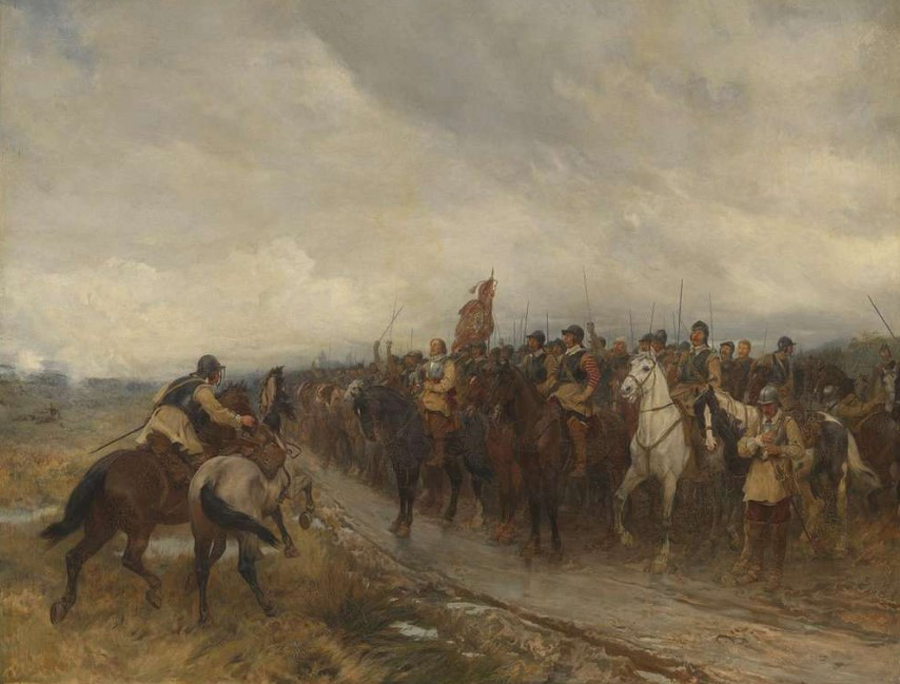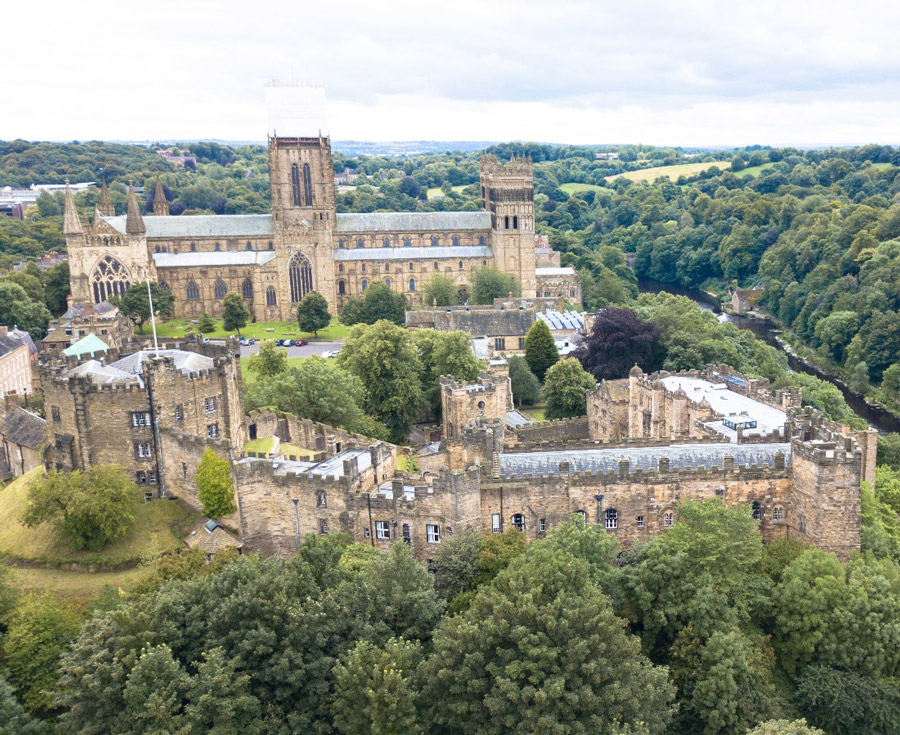In 2013, the skeletal remains of between 17 and 28 people were discovered in two mass graves close to Durham castle and cathedral. Archaeologists initially believed they had stumbled upon a medieval extension of Durham Cathedral’s cemetery.
Analysis of the remains, however, cleared up a centuries-old mystery. Many Scottish soldiers were known to have been taken prisoner by Oliver Cromwell’s English parliamentarian army after the bloody Battle of Dunbar in 1650 and incarcerated in Durham Cathedral.
But there were no clues to where they were buried after they died. Now, research on the remains has established they belong to Cromwell’s Scottish prisoners of war (POWs) and their fascinating story has been pieced together bit by bit.
The remains were discovered during construction of a new café for Durham University’s Palace Green Library, which is part of the city’s UNESCO World Heritage Site. The initial belief that they were ordinary cemetery burials was fast discarded. The scrambled state of the bones showed that it was a mass grave and the bodies were simply tipped in, in a seemingly military operation.
Richard Annis, senior archaeologist at Archaeological Services Durham University, told The Guardian in 2015:
“This is an extremely significant find, particularly because it sheds new light on a 365-year-old mystery of what happened to the bodies of the soldiers who died. Their burial was a military operation: the dead bodies were tipped into two pits, possibly over a period of days. They were at the far end of what would have been the Durham castle grounds, as far from the castle itself – they were out of sight, out of mind.”
The English Civil War and the Battle of Dunbar
The Battle of Dunbar was one of the bloodiest engagements in the English Civil War of the 17th century. Initially the English parliament’s forces and the Scottish Covenanters were allies in the Civil War against King Charles I. After his defeat and execution in 1649, however, the Scottish forces accepted his son Charles II as king and fought on the side of the Royalist troops.

The Battle of Dunbar was fought on 3 September 1650 between the English parliament’s New Model Army led by Oliver Cromwell and the Scottish Covenanter troops under David Leslie near Dunbar in Scotland. It was the first major battle in the 1650 invasion of Scotland.
- Hundreds of Skeletons at Roopkund Lake of the Himalayas
- Were There Any Victors at the Battle of Clontarf?
Lasting less than an hour, it led to a rout of the Scottish forces. Anywhere between 300 and 5,000 Scottish soldiers are believed to have perished in the battle and around 6,000 were taken prisoner. Of these, only the very sick and wounded, numbering around 1,000, were set free.
The remaining 5,000 were marched 111miles (179 kilometers) south from Dunbar to Durham. Around 1,000 of the prisoners perished on the way due to hunger, exhaustion and possibly dysentery. Some managed to escape and others were executed for attempting to.
Eventually some 3,000 soldiers reached Durham and were imprisoned in the then disused Durham castle and cathedral. Around 1,700 of these prisoners died in Durham of cold, malnutrition and disease, an average of 50 dying each day. Those who survived were sent to work as indentured labor in the American colonies.
Historians have long believed that the 1,700 soldiers who died here were buried in the area but did not know exactly where until the mass graves were unearthed. Possibly, there may be more mass graves under buildings close to the cathedral where the remaining soldiers’ bodies are buried.
Piecing the Evidence Together
The two mass graves were carefully excavated by Durham University archaeologists and a series of scientific tests was carried out on the bones. The results were combined with historical context. The skeletons were analyzed for information on age and sex, which confirmed them in the view that these were the remains of soldiers rather than common folk.
Anwen Caffel, an archaeology research fellow at Durham University told Live Science in 2016, “This indicated all of the adults were males, and there was quite a narrow age range present between the age of about 13 and 25. This would be indicative of a military context rather than the general population.” The skeletons of the young boy soldiers showed very little healed trauma, indicating that they were fairly inexperienced and Dunbar may have been their first time in battle.
Two of the skulls had crescent-shaped wear and tear or “pipe facets” in their teeth, consistent with smoking clay pipes. Clay pipes were commonly in use in Scotland until after 1640. Isotopic analysis of dental enamel indicated that the soldiers were not locals but of Scottish or northern England origins. Radiocarbon dating also placed the bodies between 1625 and 1660.
- Laughing in the Face of Death? The Merry Cemetery of Romania
- Villages and Tombs Under a U.S. Military Base in Gricignano, Campania
Andrew Millard, senior lecturer at Durham University’s department of archaeology told The Guardian, “Taking into account the range of detailed scientific evidence we have now, alongside historical evidence from the time, the identification of the bodies as the Scottish soldiers from the Battle of Dunbar is the only plausible explanation.”
Honoring the Remains of the “Dunbar Martyrs”
In parallel with the scientific analysis of the bones, Durham University was carrying out a wide consultative process on how best to respectfully commemorate the remains once the examination of the bones was complete. There was a call to repatriate the remains to Scotland, but in 2016 the decision was taken to rebury them in Durham.

David Cowling, the pro-vice-chancellor for arts and humanities at Durham University, was quoted in the same The Guardian report that the university had explored all options before deciding to rebury the remains in Durham, and commemorate them with a plaque. “We were acutely aware of the strength and depth of interest amongst many about the fate of these soldiers, whilst at the same time recognizing our ethical, moral and legal obligations.”
The plaque honoring the soldiers was unveiled in May 2017, accompanied by a minute’s silence and a lecture about the soldiers. The plaque is mounted on stone quarried from the site of the Battle of Dunbar and has been installed in the Palace Green Library’s cafe courtyard. An earlier plaque dedicated to the memory of the soldiers in 2011 was also updated to remove mention of the place of burial being unknown.
On 18 May 2018, the remains were finally reburied in a bespoke casket at Elvet Hill Road Cemetery in Durham, less than a mile from the site where they were found. A dignified graveside service was held in keeping with the traditions of the 17th century, designed by Durham Cathedral to include psalms from the 1650 Scottish Psalter and a bible reading from the 1611 King James version. A simple headstone will mark the grave, revealing who the soldiers were and where and when their remains were found and when they were reburied.
With their reburial, a remarkable project that evoked much public interest and gave important historical insights into a crucial battle of the English Civil Wars drew to a close. It gave researchers the opportunity to learn a great deal about the health and medical conditions of 17th-century soldiers from Scotland.
Top image: Thousanda died during and after the Battle of Dunbar. Source: November1711 / Adobe Stock.
By Sahir Pandey